Birds make great pets, and their ability to talk is fascinating. Some birds can mimic household sounds or even learn hundreds of words. If you want a bird that loves to chat, there are many species that are known for their talking skills.
Consider Puck, a parakeet with an amazing 1728-word vocabulary. He’s a small bird with big talent. Parrots and parakeets are known for their great talking abilities. From the clear speech of an Amazon parrot to the smart talking of an African Grey, these birds can be very entertaining for their owners.
Key Takeaways
- Certain bird species, such as parrots and parakeets, are renowned for their impressive talking abilities.
- A parakeet named Puck set a record with a vocabulary of 1728 words.
- African Greys and Amazon parrots are known for their clear and extensive vocal skills.
- Budgerigars hold world records for the largest bird vocabularies, learning long and short phrases.
- Cockatoos, while not top talkers, can still learn some words and phrases with extensive training and socialization.
If you like the sound of birds singing or want a pet that can mimic sounds, talking birds are interesting. By looking into different species, you can find the perfect bird to bring joy and conversation to your home.
Explore the world of talkative birdsand discover which species might be the best fit for your lifestyle and home.
Introduction to Talkative Birds
The world of birds is full of amazing vocal talents. From mimicking talkative birds to natural vocal birds, they amaze us with their communication skills. But what makes a bird able to talk, and how do we understand their speech and communication?
The Charm of Vocal Birds
Many bird species can mimic sounds, including human speech. This talent entertains us and helps us connect with birds. Talkative birds can form strong bonds with owners, responding to commands and even chatting.
Factors Influencing a Bird’s Ability to Talk
- Intelligence: Smart bird species, like parrots and mynahs, can learn more speech and communication.
- Social Needs: Birds that love to interact are more likely to learn many words.
- Training: Training with patience and repetition helps a bird talk better. Positive feedback is important.
“A bird’s ability to talk is a true marvel, a testament to the incredible adaptability and intelligence of these feathered creatures.”
The African Grey parrot and the budgie show how amazing vocal birds can be. By knowing what affects a bird’s talking ability, we can connect better with these incredible friends.
African Grey Parrots: The Feathered Linguists
The african grey parrots are amazing talking birds. They can learn over 1,000 words, which is like a 2-3 year old human. They can mimic many sounds, from human speech to sounds from nature.
Alex, a famous African grey parrot, lived to be 31 and knew over 100 words. He could answer questions correctly 80% of the time. These talking parrots can recognize colors, shapes, and even abstract ideas like “bigger” and “smaller.”
These intelligent parrots show emotions like surprise and anger. They understand personal pronouns and can ask questions. This shows they have a deep level of self-awareness and language skills.
“African Grey Parrots are among the six groups of animals with complex learned vocalizations, representing a small minority compared to other bird species.”
African greys have a special brain structure that helps them learn and mimic sounds. This skill is key for their survival and talking to each other in the wild.
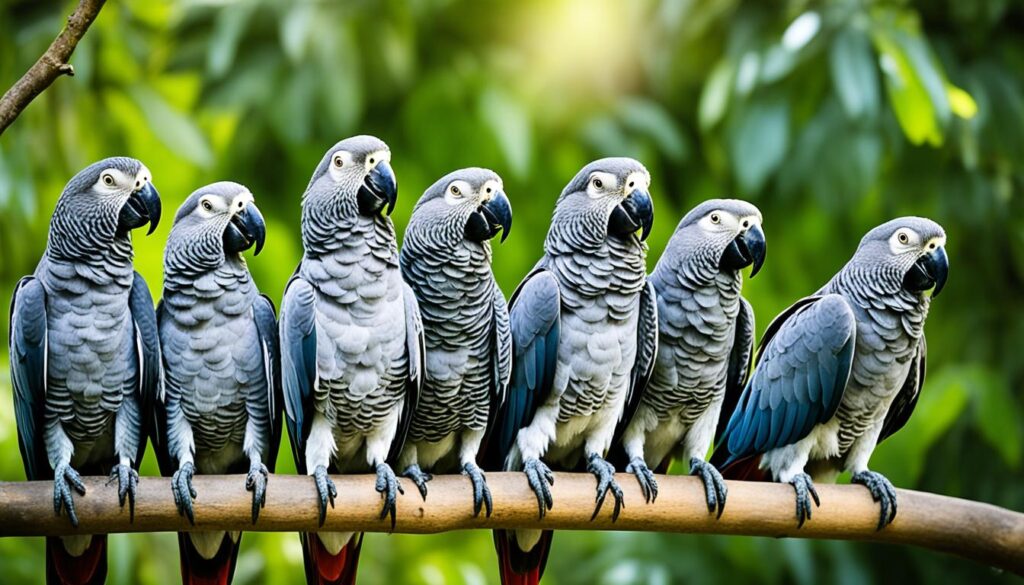
Even with their great minds, African grey parrots can be a bit naughty. They might cause trouble and bite if not trained right. These birds need a lot of time and patience from experienced owners.
Budgies: Small but Mighty Talkers
Known as budgies or parakeets, these birds are tiny but powerful. They are 6–8 inches long and weigh just an ounce. Yet, they hold the record for the biggest bird vocabularies. They can learn to say long phrases and even sing.
Budgies are not as loud as some birds, but they mimic human speech well. To help them talk more, get a young bird from a rescue or a trusted breeder. Show them lots of human words and phrases to grow their vocabulary.
Training Tips for Budgie Vocabulary
- Start training budgies young, when they’re most open to learning.
- Use short, frequent training sessions to avoid overwhelming them.
- Give treats or praise to encourage good behavior.
- Keep repeating simple words and phrases for best results.
- Introduce your budgie to different sounds and voices to expand their vocabulary.
- Be patient and consistent, as budgies take time to learn new words.
With the right training and patience, budgies can become amazing talkers. They’ll impress their owners with their skills.
“Budgies are the most popular pet bird globally, with cockatiels surpassing them in popularity only in the United States.”
Cockatoos: Affectionate and Occasionally Vocal
Cockatoos are charming and captivating birds. But, their need for constant companionship can be a challenge. They become clingy, needing hours of daily interaction with their owners. While they may not talk much, they can learn a few words to get attention.
These birds live over 30 years, making them a big commitment. There are 21 cockatoo species from Australia and other places. They’re known for their unique crests and beautiful feathers. But, their love for talking can be a drawback for those wanting peace.
Cockatoos love being around people and need lots of attention. Owners must be ready to give them the care they need to avoid problems like feather-picking. Even though they don’t talk much, their sweet nature and loyalty make them great pets for those who love birds.
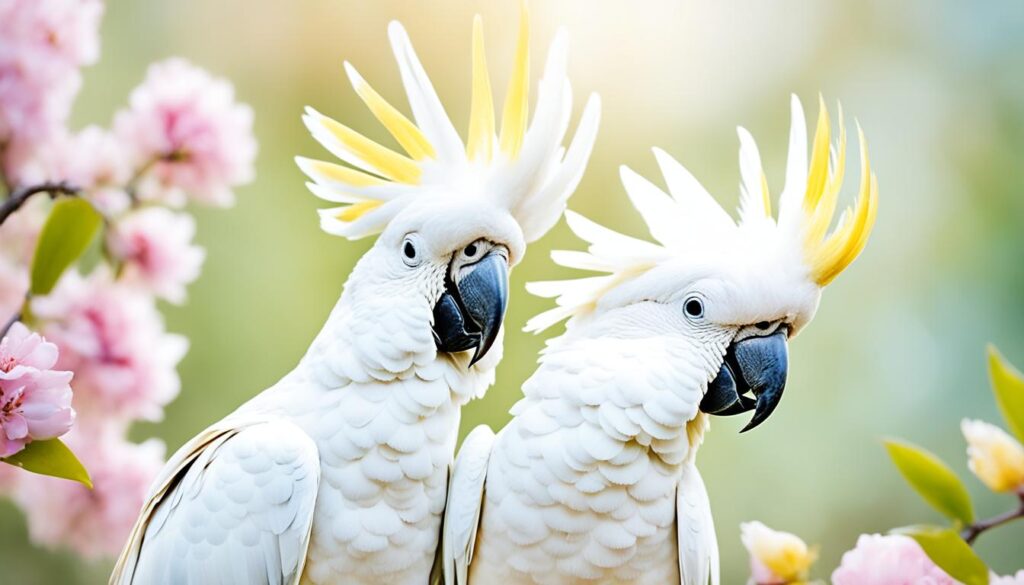
“Cockatoos can be quite noisy, especially when they aren’t getting what they want.”
Amazon Parrots: Clarity of Speech
The Amazon parrot, especially the Yellow-Naped Amazon Parrot, is known for its clear speech. Unlike Parakeets, which can sound muffled, Amazon parrots speak words and phrases clearly. They are often as clear as humans when they talk.
Training Techniques for Amazon Parrots
Amazon parrots are great at talking and singing. They are friendly and make great pets, fitting well with other birds or pets. To help them talk better, owners can use different training methods:
- Provide toys and foraging activities to keep their minds sharp.
- Use treats and praise to encourage them to make sounds.
- Introduce them to many sounds and words to grow their vocabulary.
- Keep training regular, as repetition helps them learn new sounds.
With patience and the right training, Amazon parrots can become experts at clear speech. They will amaze their owners with their skills.
“Amazon parrots are considered to be better singers than many human vocalists.”
In captivity, Amazon parrots are as smart as small primates. This makes them easy to train and learn from. By knowing what these birds need, owners can make them great and fun companions.
What birds talk the most?
Parrots are the top talkers among birds. They are smart and love to chat, mimicking human speech and learning lots of words. Some parrot species are especially good at talking.
The African Grey Parrot is known as the best talking bird. It’s as smart as a human toddler. These parrots can learn hundreds of words and have deep conversations.
- The Budgerigar, or parakeet, holds the record for the biggest bird vocabulary. They are amazing at mimicking speech.
- The Yellow-Naped Amazon Parrot is one of the top Amazon birds for talking. They learn a lot of words and speak clearly.
- The Hill Myna is not a parrot but is great at mimicking people’s voices. It can change pitch and tone like a pro.
Other birds known for their talking skills include the Double Yellow Head Amazon, Yellow-Crowned Amazon, Eclectus Parrot, Indian Ringneck Parakeet, and Quaker Parrot. These birds are known for their clear speech, big vocabularies, and sounds like humans.
“Parrots are the most common and brightly colored talking birds, with some species like the African Grey capable of expanding their vocabulary to hundreds of words.”

Talking birds are fascinating, but they need a lot of time and special care. If you’re thinking of getting a bird, make sure to learn about their needs and how to train them. This way, you can have a happy and meaningful relationship with your bird.
Quaker Parrots: Fast Learners for Beginners
If you’re a beginner looking to keep a talking parrot, quaker parrots, also known as monk parakeets, are a great pick. These small, gentle birds (11–12 inches, 3–5 ounces) learn fast. They are easy to train and can pick up new words and phrases quickly.
Quaker parrots start talking when they are weaned, and some learn a lot, just like bigger parrots. They don’t have as many words as African grey parrots, but their voices are clear and easy to understand for beginners.
“Quaker Parrots are ranked as the 9th best talking birds, capable of learning a large vocabulary of words and phrases.”
Talking parrots for beginners are smart and social, making them great friends. With their quick learning skills, quaker parrots are perfect for those new to having birds at home.
Indian Ringneck Parakeets: Masters of Phrases
The Indian Ringneck Parakeets are true experts in mimicry among talking parakeets. They are a bit bigger, measuring 14–17 inches and weighing about 5 ounces. They can learn and repeat longer phrases, not just single words.
These parakeets are known for their clear, easy-to-understand voices. They make great pets for those who want to teach their birds to talk. In some places, they are seen as sacred animals because they can learn and say prayers.
“Indian Ringneck Parakeets can live up to 25 years in captivity, indicating a long-term commitment for pet owners.”
Indian Ringneck Parakeets have a special way to store food in their crop for later. They are curious, loving, and like to be independent. These traits make them great pets for those who are ready to care for them.
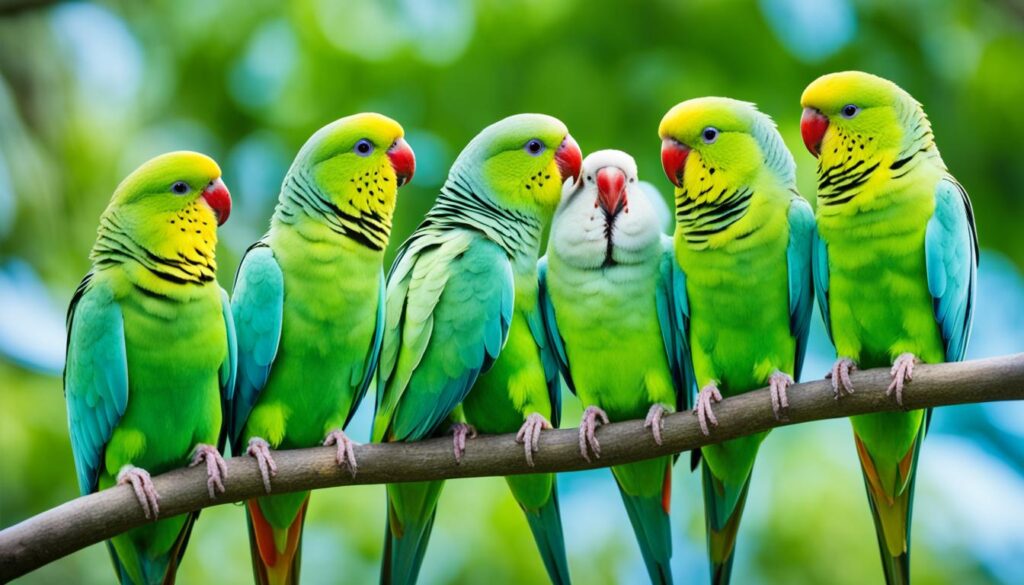
If you love birds or are new to talking parakeets, the Indian Ringneck Parakeet is an interesting choice. With patience and the right guidance, these parrots learning phrases can become clear talking parrots. They will fill your home with their sweet voices.
Eclectus Parrots: Gentle Talkers
The eclectus parrot is a standout among talking birds for its gentle nature and amazing voice. These parrots come from the Solomon Islands, Indonesia, New Guinea, northeastern Australia, and the Moluccas. They are known for their bright colors and great ability to mimic sounds.
Gender Differences in Eclectus Talking Ability
Male and female eclectus parrots look very different. Males have bright green feathers and a beak shaped like a horn. Females have a beautiful red color, a deep violet belly, and a black beak. This difference also shows in how they talk.
Male eclectus parrots are usually easier to train and know more words than females. But both males and females can learn many words and phrases. This makes them great and fun to have around.
“Eclectus parrots are gentle, friendly birds known for their ability to mimic human speech with high clarity and tend to be less noisy compared to other parrot species.”
Eclectus parrots can live up to 30 years. They need a lot of time and special care. They need a diet low in fat but high in fiber and a big cage. But, their gentle nature and great talking skills make them a good choice for those who can give them the right care.
Macaws: Big Voices, Big Personalities
Macaws are truly captivating birds, known for their large size, vibrant colors, and amazing voices. They can make a wide range of sounds, from loud screeches to soft whistles. Their big personalities are just as impressive as their ability to talk.
There are 18 living species of macaws, each with its own character. Some, like the glaucous and Spix’s macaws, are endangered. Others, like the blue-and-gold, green-winged, and scarlet macaws, are popular pets. Macaws are sexually monomorphic, meaning they look the same, but their unique personalities show in how they act and interact.
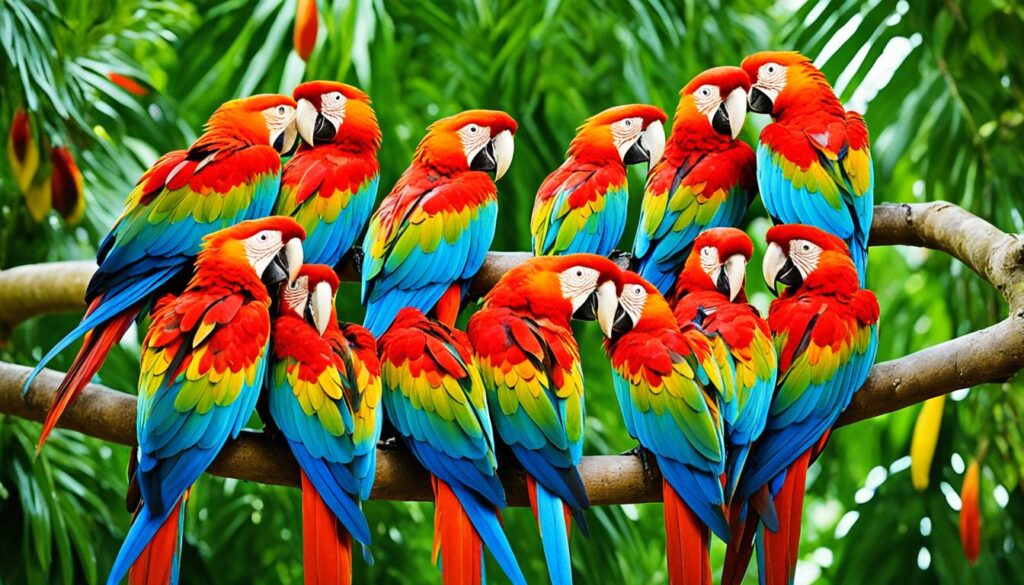
Macaws are very smart and love to talk and be social. They can live over 30 years in captivity, so owning one is a big commitment. They eat seeds, fruits, and flowers, showing how adaptable they are.
Macaws have bare facial patches that change color when they’re excited. These patches, along with their loud voices, make them very charismatic. But, they can also destroy their feathers and get sick, so they need careful care.
Despite the challenges, macaws’ big personalities and talking skills make them loved by many. They are social birds that like to talk, making them great for experienced owners who can give them the care they need.
Myna Birds: Mimicry Masters
Looking for a bird that can mimic many sounds? The myna bird is your best bet. These birds are smart and love to talk. They can learn up to 100 words and make many sounds, like whistles and screeches.
Myna birds are known for their amazing mimicry skills. They love to show off their vocal talents to people.
Caring for the Unique Myna Bird
Myna birds make great pets but need special care. They eat mostly fruits, which makes their poop soft and smelly. So, they need a special diet and careful attention to stay healthy.
These birds don’t like being cuddled or trained like some parrots do. They are more independent. But, they do bond strongly with their owners and enjoy their company.
Myna birds do well in cages but need lots of space and things to do. They need a big cage, lots of playtime, and things to keep them busy. This keeps them happy and healthy.
“Myna birds are true masters of mimicry, capable of learning and reciting an impressive repertoire of sounds, from simple whistles to complex words and phrases.”
Considerations for Choosing a Talking Bird
Getting a bird is a big step that changes your life. It’s like getting a new dog. Some parrots make very loud noises that can bother your neighbors. Others are quieter and like to chat. Make sure you know the personality of the bird you want.
Noise Levels and Living Arrangements
African Grey Parrots and Amazon birds are great at mimicking human speech but can be loud. Smaller birds like Budgies and Quaker Parrots are quieter and better for small spaces. Think about how much noise you can handle before picking a talking bird.
Time Commitment for Training
Training a bird takes a lot of time and patience. Parrots can start learning English at three months old. They keep getting better with regular talk and practice. This is how you get a bird that talks to you.
Choosing a talking bird means thinking about the noise level and how much time you can spend training. With the right effort, you can have a bird that loves to chat at home.
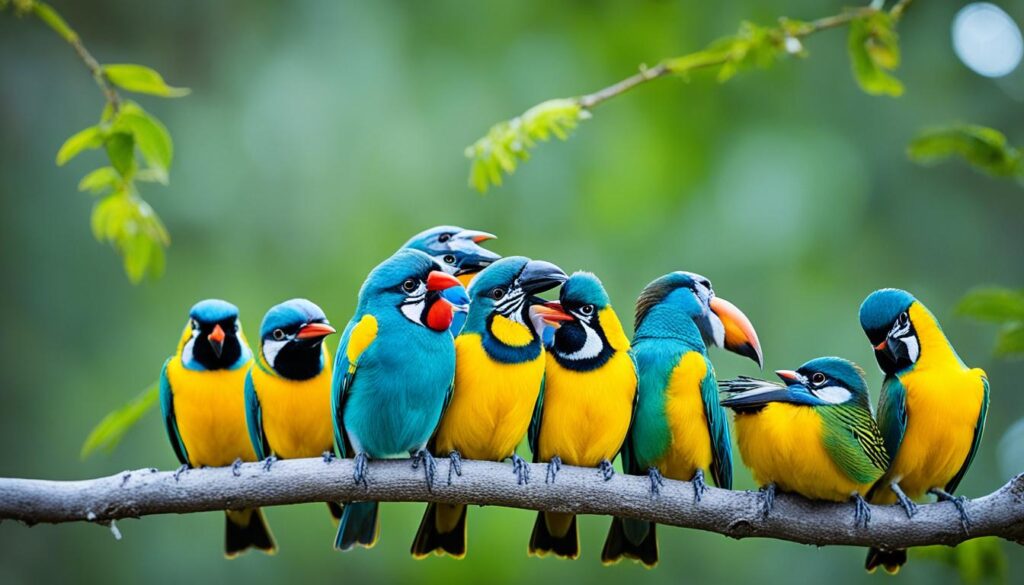
“Parrots will speak in relevant languages they have heard, like English, Japanese, or Arabic.”
Conclusion
Birds make great pets, especially because of their ability to talk. Species like African Grey Parrots, Budgies, and Cockatoos are known for their speech skills. But, any bird can learn to talk with the right training and attention.
Intelligence, social needs, and training affect a bird’s talking ability. When picking a talking bird, think about the species and the bird’s personality. Also, consider if you can give the bird the time and care it needs.
If you’re looking into the talking abilities of Quaker Parrots, Indian Ringneck Parakeets, or Eclectus Parrots, you’ll find a world full of joy. These birds offer a rewarding experience for those who are ready to care for them.
FAQ
What are some of the most talkative bird species?
Some top talkative birds include African Grey Parrots, Budgies, Amazon Parrots, Cockatoos, Quaker Parakeets, Indian Ringneck Parakeets, Eclectus Parrots, Macaws, and Myna Birds.
What factors influence a bird’s ability to talk?
A bird’s talking skills depend on its intelligence, social needs, and training with humans.
Why are African Grey Parrots considered the best talkers?
Known as “feathered linguists,” African Grey Parrots are very smart. They can learn over 1,000 words, similar to a 2-3 year old child.
How can I train my Budgie to talk?
For a Budgie to talk well, choose a young one. Make sure it hears human speech often through regular interaction and training.
Are Cockatoos good talking birds?
Cockatoos don’t talk as much as some other birds. But, they can learn a few words and phrases, especially to get attention.
What makes Amazon Parrots good talkers?
Amazon Parrots, like the Yellow-Naped Amazon, have clear voices. They’re good at learning words and songs.
Which bird species have the biggest vocabularies?
Budgies and African Grey Parrots have the biggest vocabularies. Some can learn up to 1,000 words or more.
Are Quaker Parakeets good for beginners looking for a talking bird?
Yes, Quaker Parakeets are great for beginners. They learn human speech quickly and are easy to train.
What makes Indian Ringneck Parakeets skilled at talking?
Indian Ringneck Parakeets can learn long phrases and sentences. They have a clear voice, making them fun to train.
Do Eclectus Parrots have good talking abilities?
Eclectus Parrots are gentle and can learn many words and phrases. Males are often easier to train than females.
How much noise and chaos can I expect from a Macaw?
Macaws need a lot of training and socialization. They can be loud and cause some damage. They’re best for experienced owners.
What makes Myna Birds unique talkers?
Myna Birds are smart and social. They can learn about 100 words and phrases. They also make other sounds like whistles. But, they eat a lot of fruit, which can be challenging to care for them.
What should I consider when choosing a talkative bird as a pet?
Think about the noise, living space, and the time needed for training and socializing a talkative bird.

